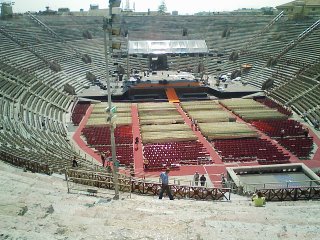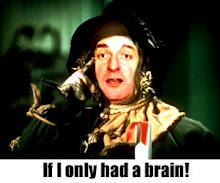Fighting Fantasy
The Arena
With the concerts of recent nights finished, the Arena was once more open to visitors. Having followed a gladiatress (a woman in full leather armour and sword walked all the way from Castelvecchio to the Arena), down to the main piazza, I got in what I thought was the line for entrance. Unfortunately it was a mass of German school kids awaiting their teacher and blocking everything up. I wasn't alone in my confusion and one only wishes that they brought the lions back occasionally. Realising our mistake, the messily gathered queue made their way around the assembled Goths and Vandals to the ticket office. I happily showed my VeronaCard (what do you need now, kids?) and marched in.
 I can readily understand the fear that must have struck victims going into the arena; I would have felt it as a spectator. We have all seen images of the arena in films and on tv, but nothing really prepares you for the feeling of size and, I suppose, menace that hits you. Workmen were taking down the stage from the previous night, so we were all restricted in where we could go, but you got the idea. When I got to the top tier of seats, I understood where the Italians got their liking for tall performance venues. As an Englishman beside me said to his wife, "I know it's safe as houses, but I still feel wobbly." I was a little wobbly myself and kept my eyes on the steps as I came down.
I can readily understand the fear that must have struck victims going into the arena; I would have felt it as a spectator. We have all seen images of the arena in films and on tv, but nothing really prepares you for the feeling of size and, I suppose, menace that hits you. Workmen were taking down the stage from the previous night, so we were all restricted in where we could go, but you got the idea. When I got to the top tier of seats, I understood where the Italians got their liking for tall performance venues. As an Englishman beside me said to his wife, "I know it's safe as houses, but I still feel wobbly." I was a little wobbly myself and kept my eyes on the steps as I came down.Whenever you need to remember just what the human animal (every human animal) is capable of in terms of darkness, keep the arenas on your list of atrocities. There is really very little difference between what the audiences then wanted and watched and what we watch today. The graphic battles and gory horror were then as much as now staples of the human entertainment appetite. What we tell ourselves now, that they're not real, they're just characters or special effects, is exactly how they must have justified it then too; the Christians were sub-human, so they weren't us, they weren't real people. Same argument as the Nazis. You might respond that in our case they really aren't people (just actors etc.), but I mean it quite literally when I say that they must really have believed the same thing. Enemies, heretics, fools, they were not real people, particularly given that we are real people and we would never do what they do. It's a matter of values, a matter of our deepest ideology, and when we change our values (as we saw in Nazi Germany), you change just what it is that you will accept.
On the way out of the Arena, I saw the warrior princess posing with her sword at a guy's throat while his wife photographed. Picture taken, they walked off. Battle not over, it seems, Xena, followed them, demanding and winning a tip.
The House of Juliet
I'm afraid I was ticking things off the list and corny or not, I didn't think I could visit Verona without seeing the so-called House of Juliet. To be fair, they make a pretty good case for it being any real Juliet's home; it was afterall the home of the Capella's, apparently the basis for the Capulets. Whether it is or not (and let's not forget that Juliet of 'Romeo and Juliet' was not a real person, whatever your value system), the entrance is covered in notes and graffiti from a million crazed lovers. Once through this tacky archway, you immediately see 'the balcony' and a statue of the unreal Juliet in the courtyard. It's pretty busy with jokers having their pictures taken holding on to one of Juliet's breasts, so i made my way as quickly as possible into the museum itself. It's a nice house, but not much else. On every floor, you're greeted with a still from George Cukor's 1936 film version of the play. Not to be outdone, the bed from Franco Zefferelli's version gets a room to itself, but at the end of the day how can you fill a museum with artifacts from a person who never existed. By the top floor, you're looking at glass cases full of ceramics.
The Tomb of Juliet
The last location on the tick list was the Tomb of Juliet. In the play she is buried in a Capuchine Church, I think. Unfortunately, that church was destroyed during the Second World War, but there's a Franciscan Church converted into another museum, and a tomb still lies intact (except for more graffiti). The Museum is full of badly damaged frescos and statues, but in the basement there are some fine Caroto's and some bizarre canvases by Louis Dorigny ("Saint Zeno stops the Cart drawn by the Demoniacal Oxen"). Up then into a pretty garden and down again into the tomb.
There was a 'Crazy Canadian' (her label) and an American already in the tomb discussing his special camera. Were it not for Freud (and the fact that she wasn't there anyway), I'm sure Juliet would have been turning in her tomb. Apparently the Canadian spent seven years in the best Make-up school in Canada. Surely a Made-up school.
The Meal of Niall
Dilly-dallying I got back to Brek at 3.00 on the dot. Unfortunately the close at 3.00 on the dot and the man wasn't letting me in. I went elsewhere and had a spinach and ricotta pizza and some wine (they won't serve carafes of water now that they've discovered they can charge you for a bottle of 'mineral water'; as it happened I'd recently murdered 1.5 litres of 'mineral water', so the wine was fine). The waiter was a bit rude though and seemed to deliberately confuse three English girls when it came time to pay. He only gave them a paper receipt when their money was on the table.
Conclusion
That's a tricky one, how do I conclude my trip to Verona, or rather where do I go from here. I have to check out tomorrow. To be continued.


1 Comments:
Nial
Ok, less of the "confusing the english and wobbly stairs."
I think you should make a point of every city your in getting one photo of at least one english lassy ;)
"luas cor ishel"
ding dong
Post a Comment
<< Home